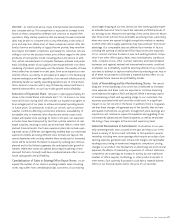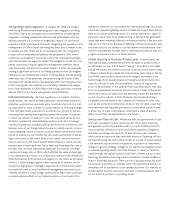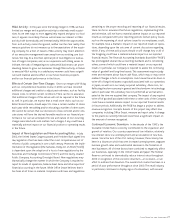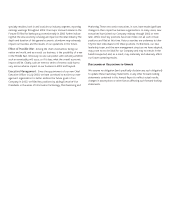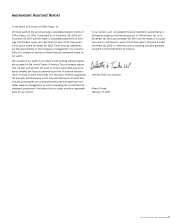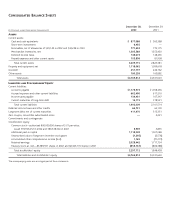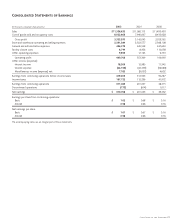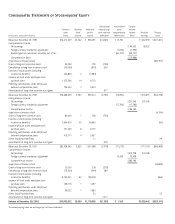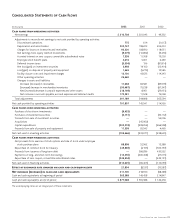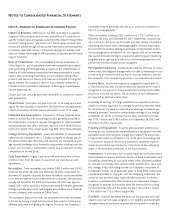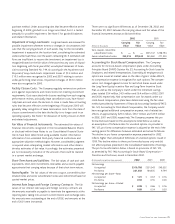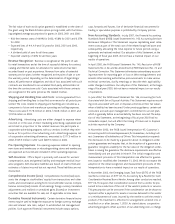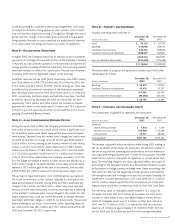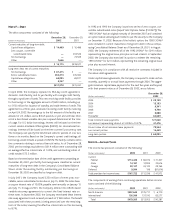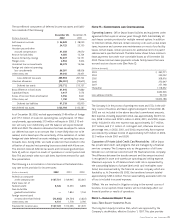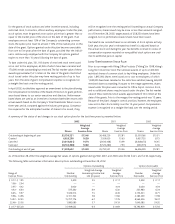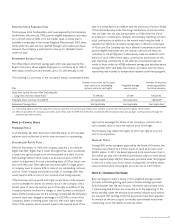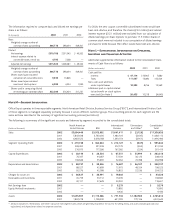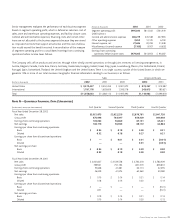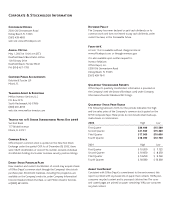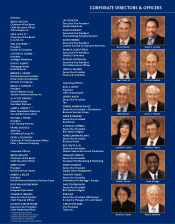Office Depot 2002 Annual Report Download - page 37
Download and view the complete annual report
Please find page 37 of the 2002 Office Depot annual report below. You can navigate through the pages in the report by either clicking on the pages listed below, or by using the keyword search tool below to find specific information within the annual report.
Office Depot, Inc. and Subsidiaries
35
purchase method. Under accounting rules that became effective at the
beginning of 2002, goodwill is no longer amortized, but it is tested
annually for possible impairment. See Note E for goodwill balances
and related information.
Impairment of Long-Lived Assets: Long-lived assets are reviewed for
possible impairment whenever events or changes in circumstances indi-
cate that the carrying amount of such assets may not be recoverable.
Impairment is assessed at the location level, considering the estimated
undiscounted cash flows over the asset’s remaining life. If estimated cash
flows are insufficient to recover the investment, an impairment loss is
recognized based on the fair value of the asset less any costs of disposi-
tion. Beginning with fiscal year 2002, we adopted Statement of Finan-
cial Accounting Standard No. 144, Accounting for the Impairment and
Disposal of Long-Lived Assets. Impairment losses of $5.4 million and
$19.3 million were recognized in 2002 and 2001 relating to certain
under-performing retail stores. Impairment charges of $63.0 million
were also recognized in 2000.
Facility Closure Costs: The Company regularly reviews store perform-
ance against expectations and closes stores not meeting investment
requirements. Costs associated with closures resulting from such ongoing
performance reviews, principally lease cancellation costs, have histori-
cally been accrued when the decision to close is made. New accounting
rules that became effective at the beginning of fiscal year 2003 will
generally delay recognition of lease termination costs from the date of
closure commitment to the date the facility is no longer used in an
operating capacity. See Note C for discussion of facility closures in 2000
and related adjustments.
Fair Value of Financial Instruments: The estimated fair values of
financial instruments recognized in the Consolidated Balance Sheets
or disclosed within these Notes to our Consolidated Financial State-
ments have been determined using available market information,
information from unrelated third-party financial institutions and
appropriate valuation methodologies. However, considerable judgment
is required when interpreting market information and other data to
develop estimates of fair value. Accordingly, the estimates presented
are not necessarily indicative of the amounts that could be realized
in a current market exchange.
Short-Term Assets and Liabilities: The fair values of cash and cash
equivalents, short-term investments, receivables and accounts payable
approximate their carrying values because of their short-term nature.
Notes Payable: The fair values of the zero coupon, convertible subor-
dinated notes and senior subordinated notes were determined based on
quoted market prices.
Interest Rate Swaps and Foreign Currency Contracts: The fair
values of our interest rate swaps and foreign currency contracts are
the amounts receivable or payable to terminate the agreements at the
reporting date, taking into account current interest and exchange rates.
No amounts were outstanding at the end of 2002, and amounts at the
end of 2001 were immaterial.
There were no significant differences as of December 28, 2002 and
December 29, 2001 between the carrying values and fair values of the
financial instruments except as disclosed below:
2002 2001
Carrying Fair Carrying Fair
(Dollars in thousands)
Value Value Value Value
Zero coupon, convertible
subordinated notes $—$—$235,747 $258,794
Senior subordinated notes 262,213 279,625 245,360 271,250
Accounting for Stock-Based Compensation: The Company
accounts for its stock-based compensation plans under Accounting
Principles Board (“APB”) Opinion No. 25, Accounting for Stock Issued to
Employees, and related Interpretations. Essentially all employee stock
options are issued at market value on the date of grant. Under APB 25,
no compensation expense is recognized for such options. The compen-
sation cost charged against income for restricted shares issued under
the Long-Term Equity Incentive Plan and Long-Term Incentive Stock
Plan, as well as the Company’s match under the retirement savings
plans totaled $9.4 million, $4.9 million and $6.4 million in 2002, 2001
and 2000, respectively. Had compensation cost for awards under our
stock-based compensation plans been determined using the fair value
method prescribed by Statement of Financial Accounting Standard (“FAS”)
No. 123, Accounting for Stock-Based Compensation, the Company would
have recognized additional compensation expense, net of related tax
effects, of approximately $29.4 million, $36.7 million and $39.5 million
in 2002, 2001 and 2000, respectively. The Company prepares this pro
forma disclosure based on the assumptions listed below, as well as
an assumption of forfeiture rates for unvested options. As provided in
FAS 123, pro forma compensation expense is adjusted at the end of the
vesting period for differences between estimated and actual forfeitures.
The decline in pro forma compensation expense presented for 2002
reflects higher than anticipated forfeitures of unvested options issued in
1999. This decline relates to these pro forma disclosures only and did
not affect expenses presented in the Consolidated Statements of Earnings.
The pro forma information below is based on provisions of FAS 123,
as amended by FAS 148, Accounting for Stock-Based Compensation—
Transition and Disclosure, issued in December 2002.
(In thousands, except per share amounts) 2002 2001 2000
Net earnings
As reported $310,708 $201,043 $49,332
Pro forma 281,332 164,335 9,794
Net earnings per share—Basic
As reported $ 1.01 $ 0.67 $ 0.16
Pro forma 0.92 0.55 0.03
Net earnings per share—Diluted
As reported $ 0.98 $ 0.66 $ 0.16
Pro forma 0.89 0.54 0.03


